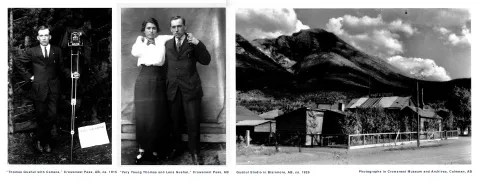Gushul History

Gushul Property Historical / Architectural Significance
Thomas Gushul (1889 – 1962) was born in Rozniw, western Ukraine, and emigrated to Canada in 1906, eventually becoming one of Alberta’s most prolific and well-known photographers. Upon arrival to Canada, Thomas worked in the coal mines then laid rail for CPR and Northern Canadian RR before meeting Lena Sawiak (1898 – 1981) also from Rozniw, Ukraine. After marrying in 1914, together they established a successful photography studio in Coleman’s “Bush town” in 1918 (Mayerchyk et al., 2022). The Gushul’s founded a second studio in Blairmore in 1921 which became the permanent work and living space for the couple and their four children (Silversides, Brock, 2002). Gushul Studio produced an abundantly rich photographic record of the Crowsnest Pass including of industrial mining, fires, parades, funeral processions, miner strikes, visiting dignitaries, the Ukrainian community and people in the region, and the spectacular natural surroundings of the Rocky Mountains and vast foothills. Thomas Gushul received many awards for his photography and, in particular, for the developments he made in mine photography. He was also well known for his portrait work. He later set up a photo-engraving plant which his son, Evan, operated for many years. After Thomas Gushul died in 1962, Lena Gushul continued to run the Studio until her death in 1981 at which time the Gushul collection was distributed to heritage sites around Alberta. The largest collection resides in the Crowsnest Museum and Archives with close to 60,000 Gushul images, negatives and artifacts. Approximately 18,000 negatives and prints are also housed at the Glenbow Museum.
Gushul Studio Restoration
In 1985 the Gushul buildings in Blairmore were restored and renovated by the Alberta Historical Resources Foundation at a cost of $160,000 and in 1986, the property was registered as a historical resource. Materials used in this restoration were the same kinds as the original materials. The Studio’s architectural significance is that it preserves the original structure. The floor is the same wood. The vaulted clerestory windows, though new, occupy the same space. The floor plan remains true to the original design with the exception of a few modifications such as an upstairs loft, added during restoration. The “Photo Studio” sign on the roof is the original sign installed by Thomas Gushul. The current Writer's Cottage was the original office quarters for the family business.
Gushul Residency Inception
In 1988 Allen Wilcke, of the Chinook Educational Consortium, informed the University of Lethbridge that the Historical Resources Foundation was seeking a program for the Gushul Studio. Hence, a proposal for an artist residency was prepared, providing an overview of how the Gushul Studio might function as a cultural resource for the Crowsnest Pass and the University of Lethbridge. Carl Granzow, Chair of the Department of Art at the University of Lethbridge, took the lead role in drafting and developing the residency program and an Advisory Committee was formed with representation from the University, the Chinook Educational Consortium, the Crowsnest Pass Ecomuseum Trust and the Crowsnest Pass Allied Arts Council. A formal three-year lease agreement was established and Sculpture Magazine advertised the program, which produced a flood of inquiries from all over North America (Williams, Carol, 2024). In 1991, the Alberta Historical Resources Foundation gifted the property and buildings for one dollar to the University of Lethbridge, and the University established the successful Gushul Residency Programs, now entering their fourth decade.
Since 1991 the studio and cottage have been available as creative residencies hosting hundreds of artists, poets, scholars, and authors, many of whom return. Residents come from across Canada, the United States, Australia, New Zealand, European nations, the United Kingdom, and Asia. Gushul Artist's and Writer's Residencies are available through an open call application process, and also through sponsorship agreements with the Southern Alberta Art Gallery, and Trap\door ARC. Undergraduate and graduate students compete annually for a fully funded spring residency through the University of Lethbridge Gushul Studio Artist Residency Prize for Art Majors. Many artists-in-residence also travel to Lethbridge to speak in the renowned University of Lethridge Lecture Series Art NOW, before returning to their home communities to exhibit, present, and publish work created during residencies. Today the Gushul Studio remains an important cultural resource for the Crowsnest Pass and the University of Lethbridge communities, and it continues to offer sanctuary for the production of new knowledge.
